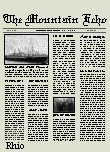![]()
Marion Co TOC
Homepage
What's New?
Awards
Cemeteries
Census Records
Courthouse Info
Family Genealogies
Heritage Society
Society's Newsletters
History + more
Marion History-book
Maps
Marion Co Timeline
Marriages
Mt Meadow Massacre
Newspapers
Obits
Photo Gallery
Post Office History
Queries
Resources
Reunions
Townships
Transcribed Records
Trip to Yellville?
Helpful Links
Contact -
Jeana
Graphics by Rhio


Special 1994 Turkey Trot Issue
Buffalo City
Reprinted from 4 Oct 1895 Mt Echo
Transcribed by: Karen L. (Hildebrand) Stevens
![]()
As Interesting Description of This Locality - Stories of the People - -
(Globe Democrat)
Buffalo City, Marion county, Ark., August 30. -- "Zinc by Thunder," the angry prospector ejaculated. He turned in disgust from the furnace, and with his partner, went down to the cabin by the creek. The two old miners gathered up their belongings, offered their interests in the property for $2.50 worth of cove oysters and left the county. This took place in Arkansas about ten years ago, and the mine from which the ore was tested has just been sold for over $200,000. The miners who found zinc were not looking for it. What they wanted was a silver mine, and when they opened on Rush Creek a face of shining ore as large as the side mountain they thought they were sixteen-to-one millionaires. With great care they constructed a stone smelter on the old Spanish principle. They burned charcoal and gathered limestone. Then they charged the furnance, started the fire, stood back and looked expectantly at the opening left for the metal to run out. Nothing appeared below, but from the top of the frunance there waved and danced red and golden and blue jets of flame. The practiced eyes of the old miners, who have been all over the Sierras and Rockies, knew the signs in an instant, and then it was that one of them raised his shout of disappointment "Zinc by thunder!"
Still earlier than this zinc had been discovered, but not as zinc. The Sutzer girls used to roam the mountain sides of Marion county looking for the cows. Their home was near where the mine was subsequently opened. From time to time the girls brought in specimens of ore. The bits of bright shining blonde were passed around the family circle, and given the homly name of "flicker." It was the talk of the neighborhood that there must be silver in that stuff. And Allen Sutzer, who had "burned barrels of powder" hunting deer in the Ozark country, got in on the ground floor. He laid claim to the land. Then the old miners came in and thought well enough of the looks of the "Flicker" to build the stone smelter. Allen took them in partnership with him. While the smelter was in process of construction some one passed along and said the ore was zinc. But the old miners thought they knew better, and carried out their test.
"Old Jim Wolfer," said Sutzer in describing the scene, when the fire was lighted, "was going around with his little bucket to catch the silver. The fumes riz up in the air and made the beautifulest rainbow you ever seen, but there was not a drap of silver come out."
A few steps from where this ore was taken to test for silver, was mined Jumbo, the 12,750 pounds of pure zinc ore in one solid chunk, which was shown at the world's fair. That was the first information most people received of the wonderful richness of the zinc fields of Arkansas. Five years ago the few pioneers hunted for straying horses where now thousands of tones of rich ore lie upon the dumps. They never suspected what was in the hills of their homesteads. The development or rather the prospecting, has all been done within that time. There has been no development to speak of. Now and then the owner of a claim has built a few barges in some tributary of the White river, and, waiting for the creek to get "up," has located out and down to Batesville, over a hundred miles away, a few tons just to show what he could do. To those who know how profitable zinc mining has been the Southwest Missouri, it may seem increditable that such ore bodies as are said to exist in the Arkansas field remain unworked. The explanation is easy. The ore is here. A novice can trace it and measure it. And when the trip to it is made, there is no difficulty in understanding why the ore lies on the dump and is left in the mine.
Marion is not all of the zinc field. In Baxter, on the east, in Boone, on the west, in Searcy and Newton counties on the south, ore bodies have been uncovered, but the masses of blends and carbonate and silicate which by their frequency, as well as their magnitude, confirmed the preconceived ideas of old miners and exceed the expectations of the tenderfeet, are in Marion.
And where is Marion county? It is a hundred miles up White river from Batesvill, on the Iron Mountain. It is seventy miles by stage southwest from West Plains, on the Gulf road. It is forty-six miles south from Chadwick, the southern-most point of the Springfield extension of the Frisco. IT is about the same distance east of Eureka Springs, the nearest railroad station on that side. And is so for north of point on the Little Rock and Fort Smith road that few think of getting in over land from the south. W. B. S.
![]()
Return to 1994 Special Issue Index Page
Return to Newspapers Index Page
Return to Marion Co Home Page
